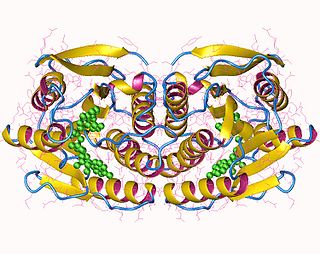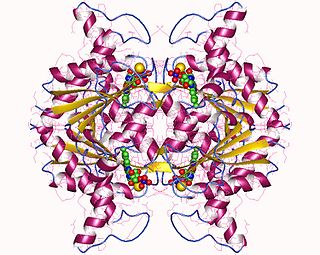
Nicotinamide adenine dinucleotide (NAD) is a coenzyme central to metabolism. Found in all living cells, NAD is called a dinucleotide because it consists of two nucleotides joined through their phosphate groups. One nucleotide contains an adenine nucleobase and the other, nicotinamide. NAD exists in two forms: an oxidized and reduced form, abbreviated as NAD+ and NADH (H for hydrogen), respectively.
In biochemistry, an oxidoreductase is an enzyme that catalyzes the transfer of electrons from one molecule, the reductant, also called the electron donor, to another, the oxidant, also called the electron acceptor. This group of enzymes usually utilizes NADP+ or NAD+ as cofactors. Transmembrane oxidoreductases create electron transport chains in bacteria, chloroplasts and mitochondria, including respiratory complexes I, II and III. Some others can associate with biological membranes as peripheral membrane proteins or be anchored to the membranes through a single transmembrane helix.
In enzymology, a 4-phosphoerythronate dehydogenase (EC 1.1.1.290) is an enzyme that catalyzes the chemical reaction
In enzymology, a cucurbitacin Delta23-reductase (EC 1.3.1.5) is an enzyme that catalyzes the chemical reaction
In enzymology, an orotate reductase (NADH) (EC 1.3.1.14) is an enzyme that catalyzes the chemical reaction
In enzymology, a precorrin-6A reductase (EC 1.3.1.54) is an enzyme that catalyzes the chemical reaction
In enzymology, a precorrin-3B synthase (EC 1.14.13.83) is an enzyme that catalyzes the chemical reaction

In enzymology, a cob(II)yrinic acid a,c-diamide reductase is an enzyme that catalyzes the chemical reaction
In enzymology, a cyanocobalamin reductase (cyanide-eliminating) (EC 1.16.1.6) is an enzyme that catalyzes the chemical reaction
In enzymology, a diferric-transferrin reductase (EC 1.16.1.2) is an enzyme that catalyzes the chemical reaction
In enzymology, a ferredoxin–NAD+ reductase (EC 1.18.1.3) is an enzyme that catalyzes the chemical reaction:

[Methionine synthase] reductase, or Methionine synthase reductase, encoded by the gene MTRR, is an enzyme that is responsible for the reduction of methionine synthase inside human body. This enzyme is crucial for maintaining the one carbon metabolism, specifically the folate cycle. The enzyme employs one coenzyme, flavoprotein.
In enzymology, a rubredoxin-NAD+ reductase (EC 1.18.1.1) is an enzyme that catalyzes the chemical reaction.

In enzymology, 6,7-dihydropteridine reductase (EC 1.5.1.34, also Dihydrobiopterin reductase) is an enzyme that catalyzes the chemical reaction
In enzymology, a cystine reductase (EC 1.8.1.6) is an enzyme that catalyzes the chemical reaction

In enzymology, a NAD(P)H dehydrogenase (quinone) (EC 1.6.5.2) is an enzyme that catalyzes the chemical reaction
In enzymology, a nitrite reductase [NAD(P)H] (EC 1.7.1.4) is an enzyme that catalyzes the chemical reaction

Methionine synthase reductase, also known as MSR, is an enzyme that in humans is encoded by the MTRR gene.
Nitroreductases are a family of evolutionarily related proteins involved in the reduction of nitrogen-containing compounds, including those containing the nitro functional group. Members of this family utilise flavin mononucleotide as a cofactor and are often found to be homodimers.

NADH:ubiquinone reductase (non-electrogenic) (EC 1.6.5.9, NDH-2, ubiquinone reductase, coenzyme Q reductase, dihydronicotinamide adenine dinucleotide-coenzyme Q reductase, DPNH-coenzyme Q reductase, DPNH-ubiquinone reductase, NADH-coenzyme Q oxidoreductase, NADH-coenzyme Q reductase, NADH-CoQ oxidoreductase, NADH-CoQ reductase) is an enzyme with systematic name NADH:ubiquinone oxidoreductase. This enzyme catalyses the following chemical reaction:







